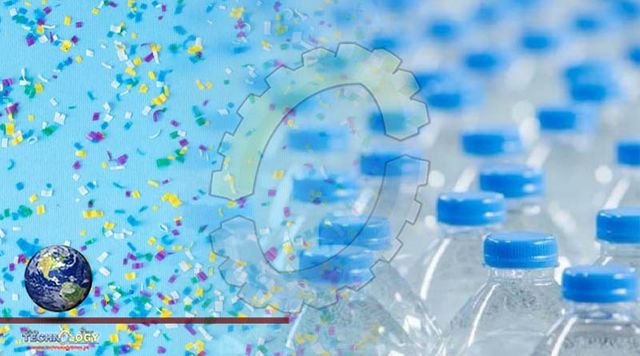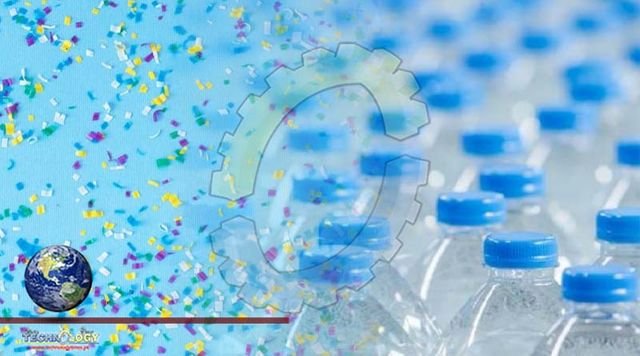The majority of us don’t purposefully eat plastic, but that doesn’t mean we’re not consuming it every day. Microplastics, which are tiny plastic fragments, are everywhere—including inside of our bodies, according to mounting research. For the first time, researchers found that 17 out of 22 people had microplastics originating from common products in their blood, according to a May 2021 paper published in the journal Environment International.1

“This is the first study to identify plastics that we know are in containers, plastic bottles, clothing, and other products that we use, inside of people,” Andrea De Vizcaya-Ruiz, PhD, an associate professor in the department of environmental and occupational health at the University of California, Irvine, tells SELF. The two most common types of plastic found in the study were polyethylene terephthalate (PET), which is used to make plastic water bottles and clothing fibers, and polystyrene, which is found in food packaging, disposable utensils, and straws.
In March 2022, researchers published a paper with another original discovery: 11 out of 13 people had microplastics in their lungs, according to the study published in The Science of the Total Environment.2 Numerous other studies support that we’re regularly consuming plastic, Kelly Johnson-Arbor, MD, a medical toxicologist at MedStar Health in Washington, D.C., and co-medical director at the National Capital Poison Center, tells SELF. “Microplastics have been found in human saliva, scalp hair, and feces, suggesting that we are all likely exposed to these plastic fragments on a regular basis,” she says. Researchers are still exploring what this means for human health, but SELF talked to experts about what we do know.
Microplastics are tiny particles of plastic, less than 5 mm long, that are created in two ways. Primary microplastics3 are manufactured to make things like microfibers4, which are found in synthetic fabrics, or plastic microbeads, which are in some cosmetics. Secondary microplastics are formed after breaking off from larger plastic products like water bottles, car parts, and product packaging. A biodegradable item such as a banana naturally breaks down until it finally dissolves. But many plastics never decompose completely. They get smaller and smaller over time, but the pieces remain in our environments as pollution for hundreds of years, resulting in secondary microplastics, Dr. De Vizcaya-Ruiz says.
Microplastics are tiny particles of plastic, less than 5 mm long, that are created in two ways. Primary microplastics3 are manufactured to make things like microfibers4, which are found in synthetic fabrics, or plastic microbeads, which are in some cosmetics. Secondary microplastics are formed after breaking off from larger plastic products like water bottles, car parts, and product packaging. A biodegradable item such as a banana naturally breaks down until it finally dissolves. But many plastics never decompose completely. They get smaller and smaller over time, but the pieces remain in our environments as pollution for hundreds of years, resulting in secondary microplastics, Dr. De Vizcaya-Ruiz says. “When humans consume food, drink water, or breathe air that is contaminated with microplastics, the plastic fragments can enter the body blood,” Dr. Johnson-Arbor says. Some estimates show that people in the U.S. consume and breathe in between 74,000 and 121,000 microplastic fragments each year5, according to Dr. Johnson-Arbor.
But how exactly do these plastics get into our blood? After consuming food or water containing microplastics, researchers suspect those tiny particles make their way to the gut, through the intestinal membrane, and into the bloodstream, Dr. De Vizcaya-Ruiz says. Something similar may happen when microplastics enter the bloodstream after being inhaled and passing through the membrane of the lungs. “Even though microplastics are known to enter the human body, scientists still don’t know how the body processes, metabolizes, or eliminates these particles. And the exact dose of microplastics needed to cause disease still remains unknown,” Dr. Johnson-Arbor says. That said, experts have a few concerns about finding microplastics in humans. For instance, scientists are studying whether microplastics may contribute to inflammation in the digestive system. People with inflammatory blood disease (IBD) had higher amounts of microplastics in their stool compared to people without IBD, according to a small study of 102 people published in the journal Environmental Science & Technology.7
Microplastics can absorb heavy metals and pesticides found in our environment, which we then absorb indirectly, adding another element that needs to be studied. “This could increase our exposure to these chemicals and could lead to poisonous effects,” Dr. Johnson-Arbor says. Plastics also commonly contain additives like phthalates, which help with flexibility, and Bisphenol-A (BPA), which makes products resilient. Some studies suggest these additives have some effect on our bodies; for example, BPA has been linked to metabolic conditions like type 2 diabetes and cardiovascular disease. However there isn’t enough evidence to say these chemicals are harmful to people in the tiny doses we get from food packages, according to the U.S. Food and Drug Administration.
Source: This news is originally published by self
